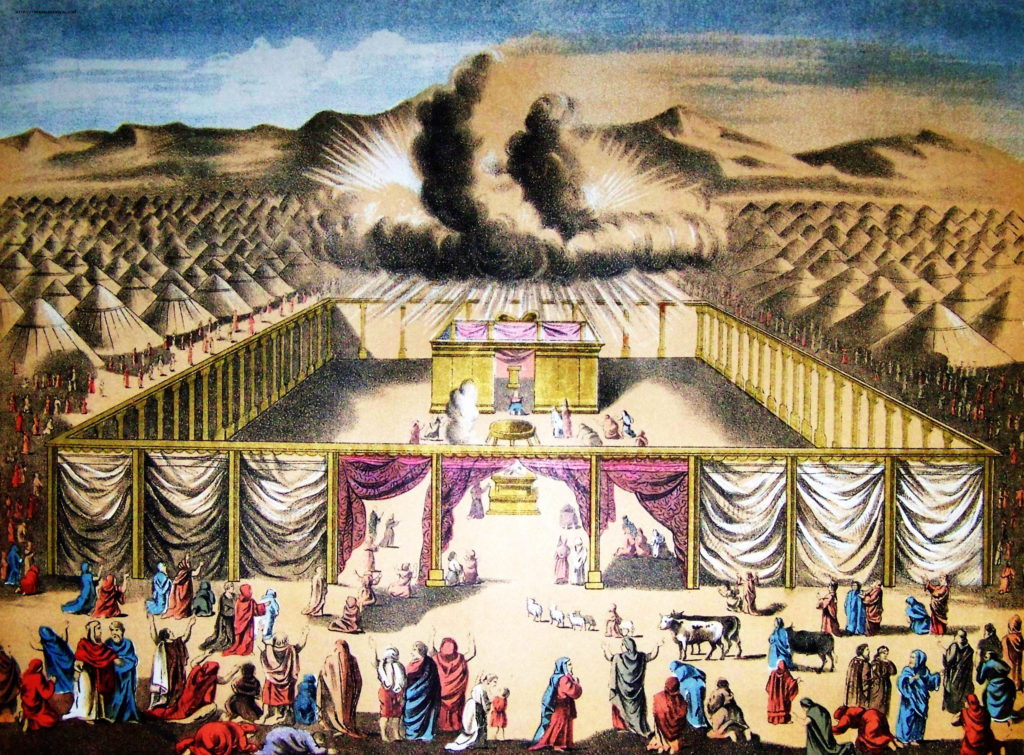[Greek] σκηνόω (skēnoō), [Latin] habitare: to have one’s tent, to dwell, to encamp, to tent, to tabernacle, to live in a tent, to reside, to occupy, to take up residence, to dwell in a tent (or tabernacle), to pitch a tent, to abide; Jn.1:14, Rev.7:15, Rev.12:12, Rev.13:6, Rev.21:3

1890 Holman Bible Illustration of the Tabernacle in the Wilderness
Background Information:
Greek Hellenism: This term means to live (or camp) in a tent. Although commonly used, this term primarily has a military sense. Xenophon’s Anabasis 2.4.14 states, “The Greeks accordingly encamped beside the city, while the barbarians had crossed the Tigris before encamping.” Xenophon’s Cyropaedia 2.1.25 states, “They live in tent each company by itself. For Cyrus thought that in occupying tents together they had the following advantages for the coming conflict.”
Skene (scene building): In the ancient Greek theater, this was originally a very light structure or just a cloth hanging from a rope. This structure was used for background scenery and a place for the changing of masks and costumes. Over time, the skene became a permanent back-stage building with columns, stairs, hidden stages, balconies, painted background panels, and doors. These doors provided the means for the actors to enter and leave the stage. The skene also served as a storage facility for supplies, props, and costumes.
Aeschylus’ Agamemnon: This play involves Agamemnon coming home (from the war) to see his wife, who plans to murder him. The skene plays an important part in defining the threshold between Agamemnon’s world (polis) and the wife Clytemnestra’s household (oikos). The house front is seen as border-line between the outdoors and indoors. The architecture of the stage (skene) defines the boundaries between the man’s world and the woman’s world. The skene helps to define where these characters dwell (abide).
Old Testament: Although extensively used, this term essentially means to dwell and to tent (tabernacle). Settling down appears both literally and figuratively. Tents and tabernacles, closely associated with residing (abiding), play an important role as the central place of worship. The tabernacle was known as the “place of divine worship.” The Hebrew word for tabernacle is mishkan. The Shekina is the glory cloud of God which dwells in the tabernacle. Tents and tabernacles both play an important roles in this wandering and itinerant culture. “Let them dwell in the place of Shem (Gen. 9:27). Do not go down to Egypt, stay in the land I tell you (Gen.26:2). Let them construct a sanctuary for Me, that I may dwell among them. As the cloud settled over the tabernacle, they remained camped (Num.9:18). Lot settled among the cities of the Plain, pitching his tents near Sodom (Gen.13:12). Justice will dwell in the wilderness (Isa.32:16). Then you will know that I am the Lord your God dwelling in Zion (Joel 3:17). For behold I am coming and I well dwell in your midst (Zec.2:10).
New Testament: This term refers to both God dwelling (tabernacling) and one residing in His dwelling place. The Latin term for tent is tabernaculum. There is no mention of the temporary nature of living in tents. Instead, the focus is on the permanent nature of abiding in tabernacles. God dwells among us and the redeemed reside in God’s abiding place in heaven. This abiding in God’s presence makes reference to the glory cloud (Shekina) of God. God’s earthly dwelling among is perhaps more clearly defined by His tabernaculing among us.
Scripture:
“And the Word became flesh and made His dwelling among us, and we saw His glory, the glory as of the Father’s only Son, full of grace and truth.” Jn. 1:14
Jesus tabernacle among us. In a sense, Jesus pitches his tent in a much grander scale.
“For this reason they stand before God’s throne and worship Him day and night in His temple. The one who sits on the throne will shelter them.” Rev.7:15
This speaks of God’s dwelling among the redeemed. This alludes to shekinah concept of God dwelling among His people.
Conclusion:
Scene, scenic, tabernacle, habitat
The Greco-Roman culture illustrates the temporary nature of dwelling (abiding) with soldiers’ encampments. The Greek theater further develops a more permanent means with the back stage. This theatrical infrastructure allows the playwright to more fully present characters in their own specific cultures (customs). The skene was a very important theatrical device to present a character’s backstory.
Tents and tabernacles are very characteristic of the itinerant culture of the Hebrews (Israelites). It is interesting to discover how the word tabernacle can be used as a verb (to tabernacle among us). This sense of tabernaculing becomes important in John 1:14. This temporary sense of residing (abiding) gives way to a permanent sense of residing (abiding) in the New Testament.
It is interesting that there are no further mention of tents in the sense of abiding. John 1:14 speaks of Jesus dwelling among us. Tabernaculing gives a better understanding of this idea. The scriptural references lead to those redeemed in the presence of the heavenly tabernacle. This alludes to the Shekinah (glory cloud of God) residing among His people.
Catholic perspective: The tabernacle is the location in the church where Christ dwells in the Eucharist. This continues with the idea of the Shekinah abiding in the tabernacle in the Old Testament. The tabernacle is a room (place) for adoration where one can sit in the presence of Jesus. This room is also a repository where the Eucharist will be stored or redistributed at Mass or given to the sick.
Jesus tabernaculing among us sets the stage (scene) for our redemption He provides for us wherever we remain (abide).
